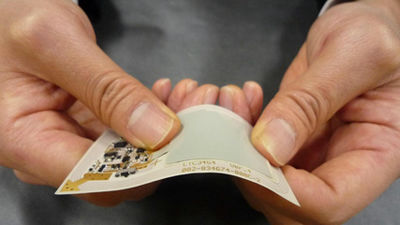Boots that can grasp accurate position information without GPS

There are ways to use GPS, but you can use GPS only within the reach of the satellite's radio waves. Although there is a method of obtaining position information by using a sensor instead of relying on GPS, it has been regarded as a disadvantage that correct measurement can not be performed with a low cost system. Meanwhile, a graduate student at the University of Utah developed a device that can accurately acquire location information even at a low price using sensors installed in the sole of the shoe.
Accurate Navigation Without GPS - IEEE Spectrum
https://spectrum.ieee.org/tech-talk/transportation/sensors/accurate-navigation-without-gps
This deviceInternational Solid State Circuit Conference (ISSCC)Those announced at. The research team at the University of Uta includes three gyroscopes, magnetometers and accelerometersInertial measurement device(IMU) based navigation system was built. High-end of the IMU is also used to navigate of the pilot of the airplane, but it Darrin Young who is the engineer of the University of Utah and wanted to develop a more portable IMU of. However, small IMU is difficult to make an accurate measurement, when you are sitting "still, these devices should indicate a value of 0. However, if for 5 to 10 minutes from sitting in the chair has elapsed, low price There is a possibility that the IMU "may have moved a few hundred meters" may be recognized, "Young says.
Young asked Qingbo Guo, a graduate student, "I want you to think about ways to keep measuring with sensors", Mr. Guo said he has presented a solution using biomechanics.
When a human walks, the heel is fixed to the ground for 100 milliseconds. Mr. Guo thought that using this "momentary" quiescence would allow the IMU to repair misplaced data. In other words, by resetting the position calculation to be calculated each time you step one step, it corrects "incorrect motion" indicated by the IMU.
Mr. Guo used to measure paceMEMSA pressure sensor is installed with the IMU on the sole of the boot. Considering that some sensors are broken due to the design of putting it in the shoe sole, Guo estimates that 1000 sensors are needed. And we created a custom circuit to integrate data from the IMU and pressure sensor data and prepared the necessary algorithm. In the prototype, the custom circuit was attached on the printed circuit board on the side of the boot. The reason for attaching the base to the outside is to make it easy to access at the time of debugging, it is said that it can also be installed on the sole of the boot or on the inside.
Mr. Guo wears boots with IMU installed, connects the system to a laptop in the backpack, and starts walking tests. The way the boots are actually walking with the structure is like the following.

Ten tests of walking around Salt Lake City over 3 km, compared with GPS data, the maximum error was only 5.5 m. In addition, GuoGolden Gate ParkWe are doing a longer distance test with.

As a result of long distance tests, the system has been shown to function regardless of the type of land and "performance is comparable to GPS," Guo says.
Related Posts:
in Hardware, Posted by darkhorse_log







